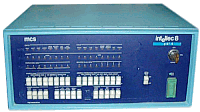::.. Something survived / Etwas hat überlebt ..::
Next Level:
What's RIO / Was ist RIO?
The Z80® processor is known all through the operating system CP/M.
He is also part of many electronic products.
Zilog® supported industrial use of Z80® family in the 70's by developing systems of their own home (ZDS, MCZ and PDS).
This acted both as a development workstation for hardware and software developers,
secondly also were used as industrial computer control systems and laboratory systems.
The operating system on these boxes was called Z80 Operating System with Relocatable Modules and I/O Management or shortly RIO.
Wer kennt ihn nicht, den legendären Z80®-Prozessor der Firma Zilog®.
Obwohl dieser Prozessor meist mit dem weit verbreiteten Betriebssystem CP/M
in Verbindung gebracht wird, findet man diesen heute noch produzierten Allerweltskerl als Kernstück
in diversen elektronischen Erzeugnissen.
Zilog® unterstützte den industriellen Einsatz der Z80®-Familie in den 70er Jahren mit
Entwicklungssystemen aus eigenem Hause (ZDS, MCZ and PDS), die zum einen als
Entwicklungsarbeitsplatz für Hard- und Softwareentwickler dienten, zum
anderen auch als Industriecomputer in Steuerungen und Laborsystemen eingesetzt wurden.
Das Betriebssystem auf diesen Kisten nannte sich
Z80 Operating System with Relocatable Modules and I/O Management
oder kurz RIO.
What's PLZ / Was ist PLZ?
Assembler programming was mainly used in the appliance industry to make optimum use of the low storage capacity. Zilog® has implemented some high-level languages on the RIO platform. So there were FORTRAN and COBOL compilers to create commercial and scientific applications. For system and hardware dependent programming Zilog developed the high-level language Programming Language Zilog, shortly PLZ (or PL/Z). This I try to document in the next stage of development of this site.
Neben der reinen Assemblerprogrammierung, wie sie vor allem in der Geräteentwicklung wegen der geringen Speicherkapazitäten üblich war, hatte Zilog® auf der RIO-Plattform auch höhere Programmiersprachen implementiert. So gab es FORTRAN und COBOL Compiler zur Erstellung kommerzieller und wissenschaftlicher Anwendungen. Für die system- und hardwarenahe Programmierung entwickelte Zilog® die Programming Language Zilog, kurz PLZ (oder auch PL/Z), die ich in der nächsten Ausbaustufe dieser Website dokumentieren werde.
Who am I / und wer bin ich?
 Well, first and foremost I'm a freak of this "extinct" technology.
My first computer experience I gathered in 1976 on a development system intellec 8 by the company Intel® (Figure).
This device has been used as a development workstation by people who developed hard and software powered by Intel®'s 8008 processor.
In 1978, I suddenly had a ZDS-1/25 available.
At this time my acquaintance began with RIO.
Well, first and foremost I'm a freak of this "extinct" technology.
My first computer experience I gathered in 1976 on a development system intellec 8 by the company Intel® (Figure).
This device has been used as a development workstation by people who developed hard and software powered by Intel®'s 8008 processor.
In 1978, I suddenly had a ZDS-1/25 available.
At this time my acquaintance began with RIO.
My website is intended as a reference to RIO, PLZ and its environment, because I've found that are almost impossible to find profound information about this technique today. At the same time it is a tribute to this technique because I grew with it in the computer world.
Nun, in erster Linie bin ich Freak dieser "ausgestorbenen" Technik. Ich hatte ich das Glück,
in der ehemaligen DDR schon frühzeitig mit Mikrocomputern Bekanntschaft zu schliessen.
Meine ersten Computererfahrungen sammelte ich 1976 an einem Entwicklungssystem intellec 8
der Firma Intel® (Abbildung). Dieses Wunderteil diente Entwicklern, die mit Intel®'s 8008
(ja, richtig gehört) Geräte- und Softwareentwicklung betrieben, als Entwicklungsarbeitsplatz.
Richtig los ging es dann 1978. Ich hatte plötzlich ein ZDS-1/25 vor der Nase. Zu diesem Zeitpunkt
begann meine Bekanntschaft mit RIO, von A5120 und PC1715, von SCP und UDOS waren wir da noch einige Jahre entfernt.
Mein Webauftritt soll eine Referenz zu RIO, PLZ und dessen Umfeld darstellen, weil ich festgestellt habe, das zu dieser Technik heute kaum noch tiefgreifende Informationen zu finden sind. Gleichzeitig ist es eine Referenz (im Sinne einer Ehrung) an diese Technik, weil ich mit ihr in die Computerwelt gewachsen bin.

